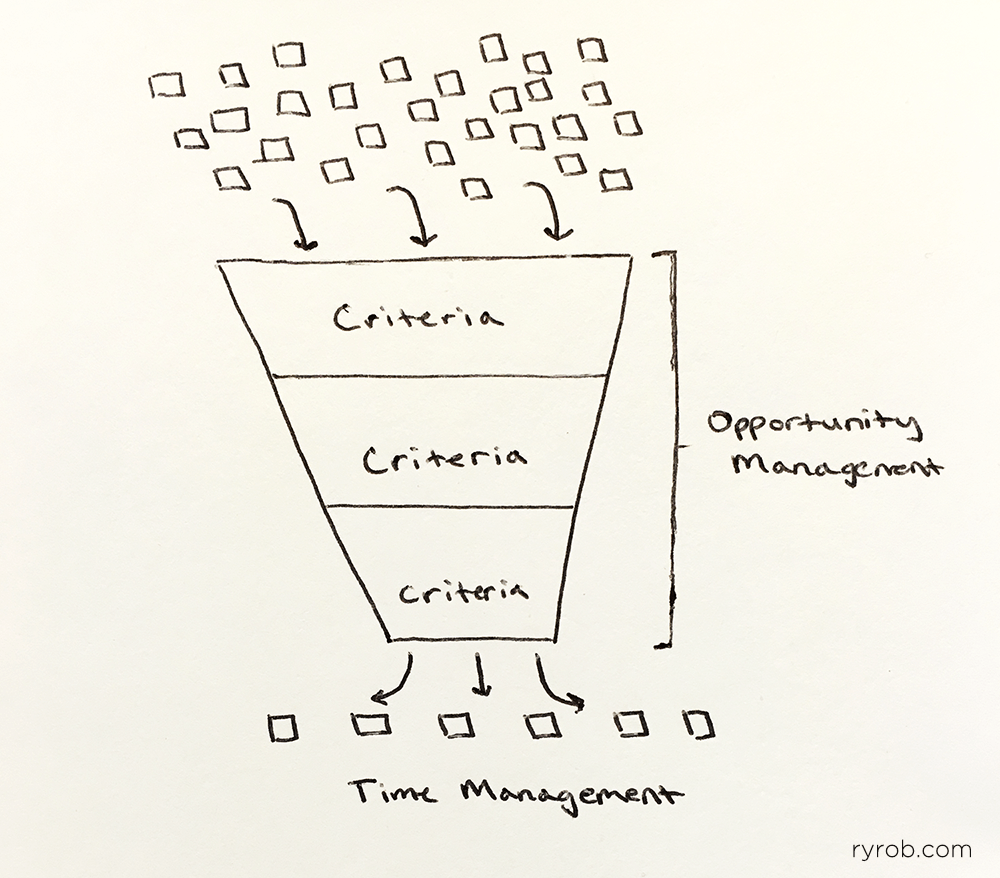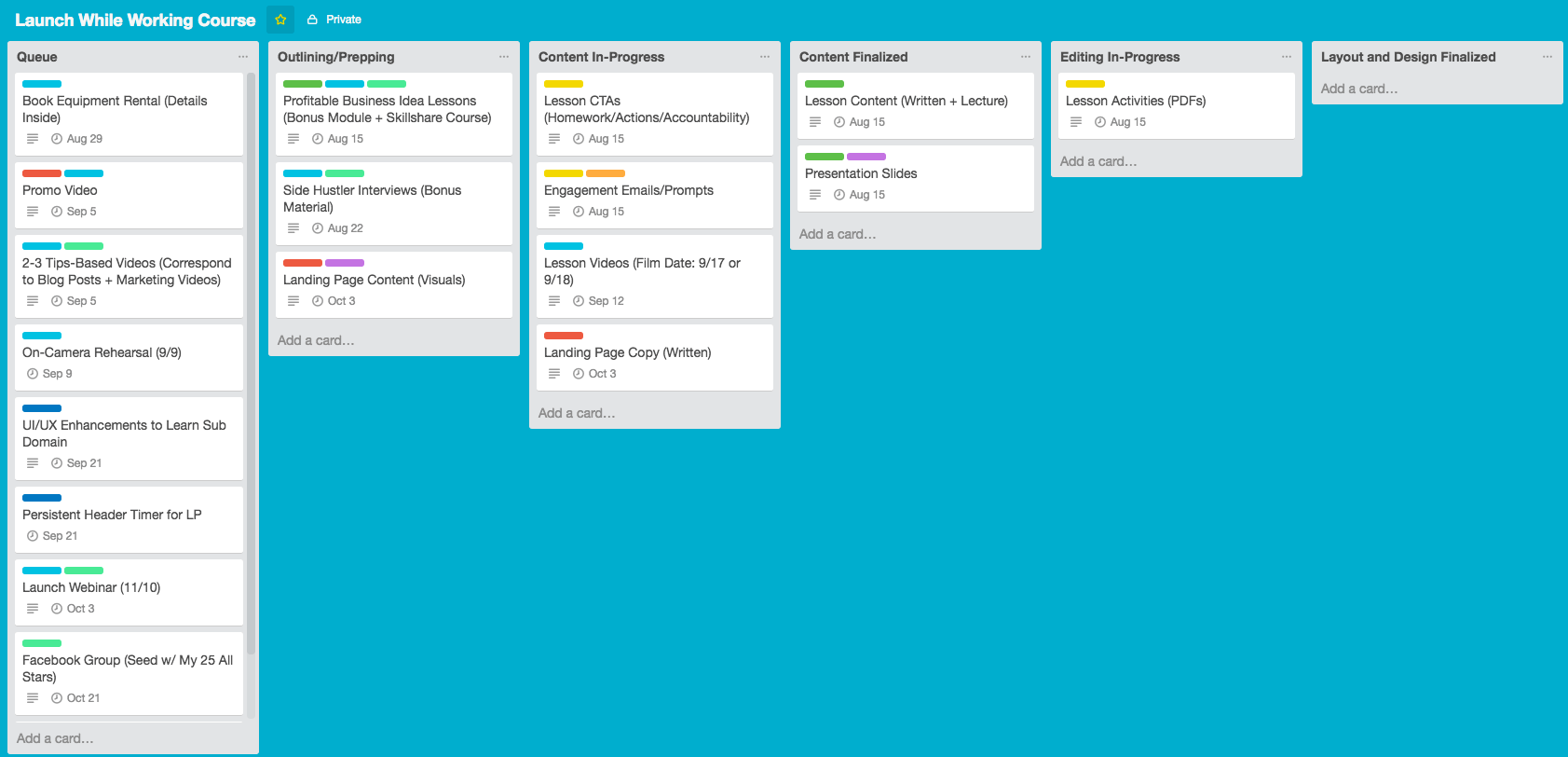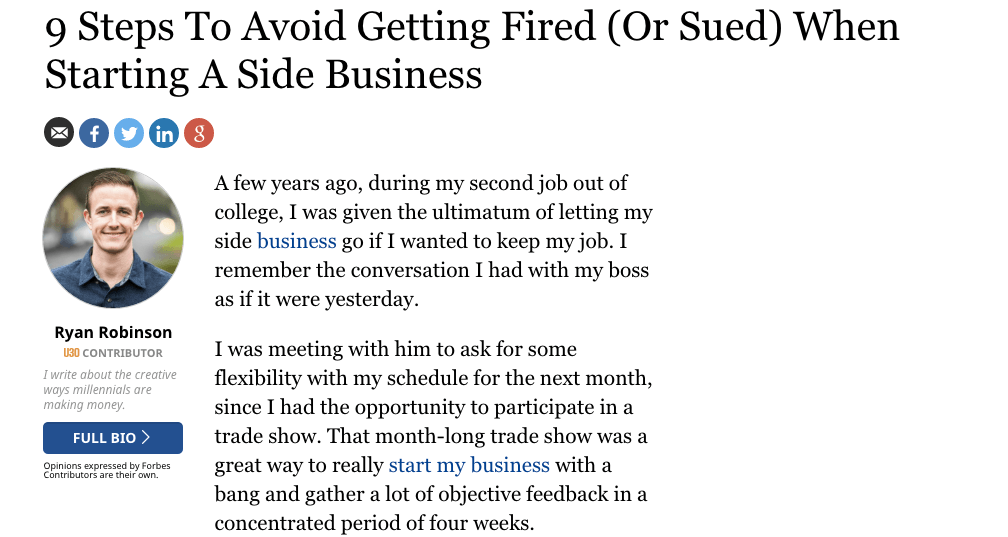Opportunity management and determining exactly what my time management system should be, has been particularly relevant to me since quitting my full-time job this month.
It’s almost comical actually. I thought that quitting my day job to focus on growing my blog and freelance business would instantly unlock a ton of time for me to pursue my business goals without distraction. I’ll be the first to admit: I was very wrong.
With an overwhelming amount of exciting work for my freelance business, my rapidly growing community of entrepreneurs reading my blog and engaging with me, offers to interview on podcasts, write guest posts, teach workshops, present at summits, and more… I’ve had to develop a very strict system for managing opportunities that come my way.
Not to mention learning how to effectively prioritize those inbound opportunities with my own internal projects and business goals. If I’m not careful, it’d be easy to spend all of my time simply managing opportunities that come my way and never complete any of my biggest personal projects.
Let me be clear: I don’t share any of this to brag, I’m really not that cool and that’s not what’s important here.
I’m writing about this because opportunity management is a major struggle for entrepreneurs in every stage of the journey. From searching for that profitable business idea all the way through to generating millions in revenue per year, how you choose to spend your time will determine how successful you become.
The first question I got from a friend while I was talking through the outline of this post was, “what is opportunity management?” So, let’s start by defining what opportunity management is (in an entrepreneurial context), what it isn’t and how it differs from time management.
Opportunity management is: A well-defined system for evaluating, selecting and prioritizing different opportunities that require the expenditure of time, financial or other resources. It’s purpose is to help you achieve your key goals in the most direct manner possible.
Opportunity management isn’t: An excuse that allows you to justify running from your responsibilities or making irresponsible decisions in the name of “pursuing your passions.”
Here’s the difference between opportunity management and time management: Think of opportunity management as the macro level decision-making process that determines what you’ll be spending your time on. It comes long before time management, which is focused on exercising conscious control over how much time is spent on the activities you’ve already decided to do (in order to maximize productivity or effectiveness).
Let’s imagine for a moment that our professional (or creative) lives are like miniature little factories.
Not just any factory though, we aren’t stamping out widgets here. We’re in complete control over what we decide to produce–what our products of choice will be throughout the course of our lives. There are all the typical competitive market factors at play, so what we produce needs to stand out as a unique product that offers true value to our customers.
Therefore, we’re rewarded more for producing goods that deliver more satisfaction (value) to our customers and we aren’t rewarded as much for turning out a product that’s identical to that of our competitors’. This line of thinking is reiterated in much of the advice that the world’s top entrepreneurs shared with me when it comes to learning how to start a business.
In our factory, it doesn’t matter much if we’re using all of the latest new manufacturing processes to speed up production or maximize output, if what we’re creating isn’t first and foremost of significant value.
What we choose to create becomes significantly more important than how we choose to create it.
Opportunity management is the what and the why. Time management is the how. If the opportunity you’re pursuing isn’t right for you, the time management and productivity systems you use, become much less relevant.
Opportunity management is your internal set of criteria that allow you to retain control of what you create.
It’s what keeps you from sitting in meetings, answering emails and chasing results that aren’t measurably advancing you toward your most meaningful professional goals. It helps you say no to the opportunities that aren’t the best use of your time.
Now that we’re clear on what opportunity management is and how essential it is to becoming successful, let’s talk about my personal system for deciding what to spend time on in my business—which revolves around activities that help me quickly and effectively validate business ideas.
Want the really good stuff?
Join me today and I’ll send you my weekly tips, strategies, and detailed insights on starting a profitable side business.
"*" indicates required fields
Opportunity Management: How to Decide What to Spend Your Time On
If you want to be successful in business, you need to start treating time as your most valuable resource.
Shout out to Derek Sivers, because his Hell Yeah or No methodology for dealing with new opportunities has had a large influence in helping me develop my own opportunity management system.
I’ve written extensively about why my default answer is no to all opportunities, both internally and externally driven, and what it takes for something to become a worthy investment of my time. So the focus of this piece is to help you build your own opportunity management system, using mine as an example.
1. Know the Change You Want to Create.
Developing your opportunity management criteria starts by having a deep understanding of who you are as a person and knowing the extremely specific change you want to create for your target audience. If you want to build a product, create an online course or start freelancing, you need to ask yourself why first.
Don’t start out with the goal of “changing the world.” As Seth Godin elaborated during a recent interview on Tim Ferriss’ podcast, in order to eventually go big, you need to start by thinking small and having a massively positive impact on just one area of the lives of an extremely well-defined group of people.
Even if it is indeed your ultimate purpose to bring clean water to everyone in the world, begin by defining your desired change as helping just one specific village become self-sufficient at converting contaminated water into a drinkable source within the next year or two.
By making your purpose very well-defined and attainable, your chances of success are significantly multiplied.
You have something specific to focus on and work towards. Once you accomplish your smaller goal, you’ll be more empowered and better equipped to move up to the next level and help ten villages become self-sufficient with their water supply. You’ll also learn a lot along the way, which will help you develop a more scalable education and deployment process for multiplying your results.
If you don’t yet know what impact you want to have or who exactly you want to help, this is where you need to pause and take inventory. Set the direction you want to work towards with your life and use a business as the vehicle for helping create that positive change. No, business doesn’t need to be a dirty word–they’re simply vehicles of change that allow you to create the lifestyle you want to live and even make money from home if you choose the right opportunities to pursue.
Join my free course on Finding a Profitable Business Idea, I’ll walk you through the process of uncovering your interests, evaluating both your soft and hard skills, then combining them together to identify meaningful business opportunities that’ll keep you motivated (more than just the next motivational quote) in the long run.
Don’t fall into the trap of following your passions, either.
I firmly believe that “follow your passion,” is the worst career advice we’ve ever been given. Your passion isn’t this elusive, magical calling that sits out there in the vast unknown, waiting to be discovered one day.
We tend to enjoy (or become passionate about) the things we’re great at doing. When you were a kid, you probably most enjoyed the sport or class subject that you were “a natural” at, right? When we get a few early breaks and experience success on the field, in the classroom or in the workplace, we gravitate towards wanting to continue doing those activities, because doing them well makes us feel good.
Over time, this cycle of simultaneously building your level of expertise and deepening your interest in your subject matter will make you an expert on a very specific topic area. That expertise is what will help you create unique value for the community you want to affect, and this is most likely to become your passion.
You don’t find your passion, you work hard at things you’re genuinely interested in until you realize you’re in love with what you’re doing.
The change I want to create this year is to personally help 250 young entrepreneurs launch a purpose-driven business that enables them leave their day jobs and become fully self-employed.
In order to accomplish this lofty goal this year, I know that I have to quickly finish up all of the content in my course and start sharing it with my community. This is my number one priority after delivering results for the freelance clients who’ve contracted me, so all other opportunities that come my way and don’t immediately help me finish my course content faster or more effectively will be politely declined at least until a later date.
Now, it’s your turn. What’s your purpose for the rest of this year? Here’s a template to fill out:
The change I want to create this year is (specific, clearly defined result)
for (specific audience or type of person you want to reach) .
2. Define Highly Specific Goals and Deliverables.
Once you know exactly where you want to go, the real work can begin.
You don’t accomplish your most meaningful goals overnight or by haphazardly choosing a set of activities you think will lead you to the result you want, so let’s build a plan of action for getting to to a very specific destination: your end goal for the year (month, quarter, half year or other timeframe).
Always start by working backwards from your end goal, and begin identifying the major deliverables you’ll need along the way. That’s how to set goals that’ll be realistic, attainable and meaningful.
If your goal is to make your first $1,000 from a brand new website in the next 30 days, you’ll need to get serious very quickly about how you’re going come up with great blog post ideas, drive traffic and hit your goal to begin making money from your blog.
Regardless of what your online business model is going to be built around (product, service or digital content), assuming you already have that product or service ready to sell, if you’re starting from scratch with your website you’ll need to do these activities:
- (Day 1): Register a domain name
- (Day 1): Set up affordable hosting for your website
- (Days 2-9): Build your website (I recommend using WordPress as a CMS and the theme I use is OptimizePress
- (Day 10): Set up payment processing (I use Stripe) or integrate with an easy-to-use online shopping cart tool (I’ve used Shopify)
- (Day 11): Come up with a plan for driving potential customers to your website
- (Days 11-30): Execute on your traffic plan
- Here are all of the other tools and resources I use to run my online business.
There are also tons of phenomenal free and inexpensive online business courses that can walk you through the process of building a blog.
Regardless, each deliverable needs to be tied to a very specific deadline, which helps you remain accountable for your own deliverable. If you miss on the deadline, you’re on the hook for why you didn’t deliver on time.
If you don’t know what needs to happen in order to reach your goal, do not make excuses. It’s your responsibility (and yours alone) to become a master problem-solver if you want to be successful in business. You need to do the research, find creative solutions, learn from other more experienced experts and be the master of your own destiny.
While I always start by hand-drawing out my action plans for major projects so I can visualize everything easily, each deliverable quickly makes it’s way into my Trello workflow. Every major project like a course, book or new website gets it’s own Trello board which serves as my project management home base. Here’s a snapshot of what my course development and launch plan looks like.
Each deliverable has a due date, which helps me prioritize what needs to be completed first before moving onto the next task. I use this same system to manage my deliverables and goals for my business as a content marketing consultant where I’m brought on to help Fortune 500 brands and high-growth startups to build and execute on a content marketing strategy.
Evaluating New Opportunities
3. Will Doing This Get Me Closer to Achieving My Goal?
This is simple, so don’t over-complicate it.
It’s tempting to try and find a justification for saying yes to an exciting new opportunity that comes your way, especially if it boosts your ego or sense of self-worth, but you need to train yourself to pull out and look at the bigger picture of your career trajectory. Ryan Holiday explores the complexities of this very challenge in his recent book, Ego is the Enemy.
Will choosing to pursue the opportunity at hand get you measurably closer to achieving your goal? More importantly, will taking the time to allocate towards this new opportunity help accelerate you towards getting your key deliverables checked off or will it stall your progress?
If the answer to this key first question is no, which 95% (or more) of inbound opportunities and new internal ideas for me are, I politely decline participation in the podcast interview, summit, quote, course or guest post opportunity. It’s not that I don’t want to take these opportunities on, it’s just not the right time. Saying yes in the short-term would negatively impact my long-term effectiveness, which would in turn hurt everyone I work with.
One of my favorite recent authors, Hal Elrod taught me a lot about the art of politely refusing opportunities when it’s not the right time to take them on, when I asked him to be a guest on my podcast recently. He kindly turned me down, suggested a future date for me to reach back out and even went so far as to suggest a handful of other people who may be a good fit for me to reach out to for the podcast in the short term, including their contact information.
Here’s a snapshot of the email Hal sent back to me after I reached out.
Going the extra mile and taking a few minutes to show a potential future partner that you’re genuinely interested in providing value to them once it makes sense for you to do so, will help keep doors open that may otherwise close if you’re completely unresponsive.
Related to this topic of keeping your leads warm, a friend of mine, Bogdan Zlatkov who runs the digital agency Pixel Press Digital, tipped me off to a great piece by Sid Savara on the Flip Side of Hell Yeah or No for when it comes to deciding how to spend your time as an entrepreneur.
Sid shares, “If your time is not being utilized at a high rate, before using Hell Yeah (or a lack thereof) as a determining factor, ask yourself – am I going to do something productive with the time I save by not taking on this project, or is this just a cop out? You don’t have to say yes to everything that comes your way – but I would at least consider dipping your toes in if you don’t have a better option.”
The more success and notoriety you get within your industry, the number of exciting opportunities coming your way will greatly accelerate. As much as we’re applying a scientific system to opportunity management, it’s really more of an art. Your system needs to evolve with you as you progress.
I’ll have edge cases where choosing to pause on a massively important priority is justified because the opportunity that came to me will completely revolutionize my business.
A recent example of this is when I was offered the opportunity to become a Forbes contributor. Sure, there was undoubtedly some ego at play in my decision-making process on choosing to accept this, but it had been a business goal of mine for several years. I determined that it would have an immeasurable future benefit for both my personal brand and my business goals if I could regularly share my experiences with the audience of one of the world’s most revered business publications.
When it comes to making sure new potential freelance clients for a work from home job you’re eyeing are a good fit with your personal brand, a friend of mine, Anna Lea Crowe, an SEO and marketing freelancer weighs in with some great advice for fellow freelancers who have trouble deciding which clients they should choose to work with.
Anna shares, “In the past, I used to take a client no matter what. If they wanted to work with me, I wanted to work with them. Now, after many lessons learned and a lot of money lost, I determine my ideal clients on three simple factors: music, clothes, and cars. If I’m a 70’s, Free People, Prius kind-of-person, and you’re a pop princess, Prada, and Mercedes lover, my aesthetic might not be what you’re looking for.”
“Next, I look for red flags. These typically come in phrases of ‘when will I rank #1 for this keyword?’ ‘how fast can you have that done?’ and my favorite, ‘I’ll pay you in equity.'”
Quick note: Check out my guide on how to do keyword research if you want to rank high in organic search.
“After I say yes to a client, I always conduct an audit because every client is different. Their needs are all different. The majority of my clients come to me for SEO. After I perform the audit, I can determine how to prioritize my time. If they have a Google penalty or a significant amount of duplicate content, this is going to take priority over writing meta data. Depending on the size of the site, it can take a month or so.”
As a freelance content marketer myself, this advice really hits home for me. If I have a call or in-person meeting with a new potential client and we don’t mesh at all on a personal level, nine times out of ten I’ll politely decline working with them. If we don’t communicate well with each other right off the bat, it’s going to lead to more problems down the line and I want to avoid those situations at all cost.
So, once I’ve decided that a new opportunity is well-aligned with my current goals and priorities, I move on to the next question I ask myself.
4. Is This More Important Than My Current Priorities?
Making it past the first test means that the opportunity is worthy of saying yes to in the short-term.
Now, it’s time to prioritize where this opportunity fits in within my current workflow. I have a few simple rules I use to expedite this process and get new tasks quickly integrated into my schedule without wasting much time fussing over the details.
Rule #1: If the opportunity takes anywhere in the neighborhood of 5 minutes or less to complete (i.e. quote requests for top tier publications or authors and other tasks in that vein), I’ll schedule it to be done later that afternoon in a 1 hour block of time I dedicated to catching up on email and powering through these types of quick tasks.
Rule #2: If the opportunity is more time (or financially) intensive, by default it goes to the very bottom of my Opportunities Board on Trello. Every new opportunity I say yes to, starts out behind all of my other current priorities without question.
Rule #3: In order to expedite an opportunity upwards within my current priority queue, I have to make a case to myself showing that reshuffling my current priorities (or a certain number of them) is worthwhile because of the positive business results that will be brought about by taking this opportunity on quickly.
In order to do this effectively, I’ll usually need to get some more details from the person reaching out so that I can assess the time investment that’ll be required, confirm any deadlines or event dates I need to be aware of, and I’m always careful to share with them what I’d like to get out of my involvement, so that there’s no misunderstanding.
By slowing moving up an urgent opportunity that has the potential to do big things for me, it’ll eventually find it’s natural place that makes the most sense within my workflow queue and I’ll get back to the concerned parties with an update about when I’ll be able to participate.
While it’s undoubtedly necessary to my line of work, when it comes to spending time answering emails, taking phone calls, meetings and attending events, I’m experimenting with allocating a 1-2 hour block of time each afternoon to work on those more reactionary tasks that don’t directly help me create my best work.








Ryan,
Your writing as a coach is getting much stronger. This is a good piece, with a deep well of actionable resources and approaches to consider.
I am tackling similar issue with opportunity management. I find myself in a constant custom proposal writing grind, with a low ROI, low commitment from supporting resources, selling to a target industry that requires transparent competitive bidding through independent RFP processes, even if pre-agreed. As a result, falling down is fitness, business planning and, in fact, revenues. As a result, once I meet this months deadlines, will rethink how to prioritize RFP/Q responses as a source of business development and how to pivot my business development into sole sourced value propositions. Not an easy equation if you want to stay on the high value, deep content, broad change side of freelancing vs. consulting.
Keep up the good work.
Thanks, Sid! Glad you’re able to pull some action out of it. That sounds like a huge challenge for you. In your experience with pitching when you don’t land the custom gig, what do you find is the most common reason clients choose to go with someone else? Is there a high degree of competition within your space? Are your prices above what your current target clients can afford?
I’d challenge you to keep thinking outside of the box. There could be (are likely) multiple different solutions to the problem of increasing your close rate. I’d be willing to bet that you could even increase your close rate and charge more for your services by adjusting who exactly you’re pitching your services to. Beyond that, something as simple as a very well built out case study/testimonial page on your website could give you the extra leverage to show potential clients the great results you’ve driven for other similar clients in the past.
Thank you for taking the time for a thoughtful reply. Noted. Feedback to suggestions best off line. Helpful in affirming I’m thinking correctly. _ Sid
This is such a nice post. All I can say is that I agree to all of these, like prioritizing or managing your time to accomplish all these opportunities will lead you to success. And how you choose to spend your time will determine how successful you become.
This is so useful! I struggle with prioritising and just end up getting excited about everything and over-stretching myself, so I’ll definitely take this on board – Thanks!
Dear Ryan…me and one of my friends have an idea of starting a service app which would provide various services to the society….the only thing is we have this idea but we do not know anything about app designing so we have made a plan of hiring an app designer …. who would build this app for us…and according to our requirements…me and my friend are commerce students .. so when this idea came in our mind we also managed to design various schemes through which this app would generate income… we do not have any capital of our own..so we have decided to show our revenue models to the angel investors…..to be completely honest we do not know where to start from I mean the field work…or the desk work…in other words the designing comes first or the revenue graphs and charts come first….we have no idea about where to start from….your advise would be very kind……nd helpful..regarding where to start from…ryt now we only have this idea nd some contacts…of app designers nothing else…can u help me in deciding what to do first and how not to waste our time….
I got your email, Surojit! I’ll reply to your questions there with more detail.
thnx…ryan appreciate it…!
Hi Ryan! So, I took the leap of faith and left my role at a digital marketing agency to branch out on my own about 7 months ago. I came across your content sometime right before then, and I have been reading it ever since as I am gaining my footing and learning about managing my own business. When I worked at the agency, I was often frustrated when we were working with clients that were just not the right fit, but at that time I had no control over which clients we received or not. Now, running my own business, I am actually in the driver seat and being challenged to be the one to say “no” when it’s needed. It is hard! But this article is a GREAT reminder of how to think about the opportunity gained or lost when saying no, and if you do decline an opportunity, HOW to politely decline. I loved that email from Hal! Thanks for sharing that. I will work on practicing these steps when evaluating my work and priorities. Appreciate your posts and will continue to follow along!
Woo! ? congrats on launching your own consulting business, that’s a huge accomplishment that you’ve been able to sustain it for 7 months so far.
What type of clients are you going for with your consultancy? Have you noticed any trends yet with what you do and don’t like doing/working with?
Thanks! It has been an awesome learning curve! While I was at the agency I always had 1-2 small clients I was working with on the side for a few years before I made the jump. Right now, I’m mainly basing clients off of 1.) Do we mesh well personally? (Like you mentioned yourself.) Life is too short to be involved in bad partnerships that you don’t enjoy. 2.) Can I truly help them make a difference? Are their expectations in line or are there red flags?” (Again, like Ann said) and then go on from there. But I’d really like to eventually work moreso with lifestyle/fitness/health/hospitality clients as those are my own personal interests and it is always enjoyable to work in an industry you care about and have personal interest in. So, as I get a little more footing, getting 1-2 clients in those industries is my goal!
You are definitely on the right track. Keep up the awesome work! Feel free to email me any time if you have questions you think I may be able to help out with (or requests to write about) 🙂
ryan@ryrob.com
Thanks, Ryan! Will do 🙂
Great content, thanks for the tips and the workflow! I agree that ‘follow your passion’ advice has been overused to the point of confusion. There’s nothing wrong with doing what you love and maybe even building a business off it, but it has to provide an ongoing challenge or teach us something new. Otherwise, it will quickly turn into ‘that thing we do for a living’
Absolutely agree! 🙂